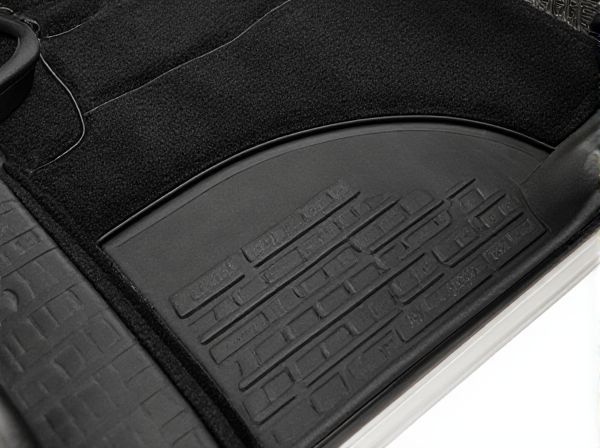
Photo illustration: Rubber Backing vs Foam Backing
Rubber backing offers superior durability and water resistance, making it ideal for high-traffic areas or moisture-prone spaces. Foam backing provides excellent cushioning and comfort underfoot, enhancing your overall comfort in living areas. Choosing the right backing depends on whether you prioritize longevity or softness for your flooring needs.
Table of Comparison
| Feature | Rubber Backing | Foam Backing |
|---|---|---|
| Durability | High resistance to wear and tear | Moderate wear resistance, compresses over time |
| Water Resistance | 100% waterproof, prevents moisture seepage | Absorbs moisture, less water resistant |
| Comfort | Firm feel, minimal cushioning | Soft and cushioned underfoot |
| Slip Resistance | Excellent grip, prevents slipping | Good grip but can shift underfoot |
| Noise Reduction | Minimal sound insulation | Better noise absorption |
| Maintenance | Easy to clean, resists stains | Requires more frequent cleaning |
| Cost | Generally higher priced | More affordable option |
Introduction to Backing Materials
Rubber backing offers durability and excellent slip resistance, making it ideal for high-traffic areas and commercial settings. Foam backing provides cushioning and sound insulation, enhancing comfort and reducing noise in residential and office environments. Choosing between rubber and foam backing depends on the specific needs for durability, comfort, and functionality in the intended space.
What is Rubber Backing?
Rubber backing is a durable, non-slip material commonly used on rugs and mats to provide excellent grip and prevent movement on various floor surfaces. It offers superior moisture resistance and long-lasting support, making it ideal for high-traffic areas and commercial use. Compared to foam backing, rubber backing delivers enhanced stability and better protection against wear and tear.
What is Foam Backing?
Foam backing is a lightweight, cushioned material often used beneath carpets and rugs to provide enhanced comfort, insulation, and sound absorption. Made from polyurethane or latex foam, it improves floor softness and prolongs carpet lifespan by reducing wear and tear. Foam backing is ideal for low-traffic areas, offering moderate durability and moisture resistance compared to rubber backing.
Durability: Rubber vs Foam
Rubber backing offers superior durability compared to foam backing due to its resistance to wear, moisture, and heavy foot traffic, making it ideal for high-traffic areas. Foam backing tends to compress and degrade faster, especially under consistent pressure, which can reduce its lifespan and cushioning performance. Choosing rubber backing ensures long-lasting support and structural integrity for flooring or mat applications.
Comfort and Cushioning Comparison
Rubber backing provides firm support and excellent durability, making it ideal for high-traffic areas where slip resistance and stability are essential. Foam backing offers superior cushioning and softness, enhancing comfort underfoot with shock-absorbing qualities that reduce fatigue during prolonged standing. Choosing between rubber and foam backing depends primarily on the desired balance between long-lasting firmness and plush comfort.
Water Resistance and Moisture Protection
Rubber backing provides superior water resistance by creating a durable, non-porous barrier that prevents moisture penetration, making it ideal for areas prone to spills and high humidity. Foam backing offers moderate moisture protection with its absorbent structure that can trap some moisture but is more susceptible to mold and mildew if exposed to excessive water. For environments requiring robust water resistance, rubber-backed materials outperform foam-backed alternatives, ensuring longer-lasting durability and easier maintenance.
Installation and Maintenance Differences
Rubber backing offers superior durability and slip resistance during installation, ensuring a stable fit on various surfaces, while foam backing is easier to handle due to its lightweight and flexibility. Maintenance for rubber-backed products typically involves simple damp mopping, as it resists water and dirt accumulation, whereas foam backing may require more frequent care to prevent moisture absorption and potential mold growth. Overall, rubber backing provides a low-maintenance option ideal for high-traffic areas, contrasted with foam backing that suits lighter use with regular upkeep.
Cost Considerations
Rubber backing generally costs more than foam backing due to its durability and slip-resistant properties, making it suitable for high-traffic areas that demand long-lasting performance. Foam backing, being lighter and less dense, offers a more budget-friendly option ideal for low-traffic or temporary applications. When evaluating cost considerations, factor in the potential lifespan and maintenance expenses associated with each backing type to determine overall value.
Best Uses for Rubber Backing
Rubber backing is ideal for high-traffic areas requiring durability and slip resistance, such as entryways, kitchens, and commercial spaces. Its moisture-resistant properties make it suitable for environments prone to spills or dampness, preventing mold and mildew growth. Unlike foam backing, rubber backing offers superior stability and longevity, ensuring rugs and mats stay securely in place on hard surfaces.
Best Applications for Foam Backing
Foam backing excels in applications requiring cushioning, sound absorption, and comfort underfoot, making it ideal for carpet padding and gym mats. Its lightweight, flexible nature provides excellent insulation against impact and noise in residential and commercial flooring. Foam backing is also preferred for removable rugs and mats, thanks to its ease of installation and moisture resistance.
 caratoz.com
caratoz.com